In the winter of 1918, Lenin wrote a letter to Soviet Education Commissar Anatoly Lunacharsky outlining his vision of a utopian socialist city. The vision included grand paintings which would line the streets like in renaissance philosopher Tommaso Campanella’s “City in the Sun”.
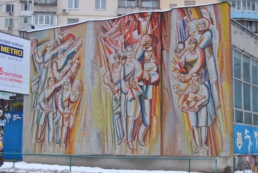
However, Lenin eventually concluded that the paintings would hold up poorly in Russia’s harsh climate. Yet the fanatical seventeenth century Catholic monk would still serve as an unlikely inspiration for Lenin’s new fantasy: commissioning weatherproof public art to “provide a lesson to youth in natural science and history and rouse their sense of citizenship”. Soon thereafter, the Soviet leadership launched the process of revamping Soviet public art by issuing a decree calling for the eradication of all monuments to the Tsar.
Nearly a hundred years later, Ukraine repeated that process, this time pulling down around 1,300 Lenin statues from all across the country following the Maidan protests of 2013. Ukraine’s decommunization law, passed in 2015, gave the removal of the monumental art an official seal of approval.
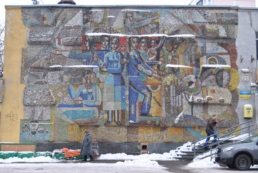
Decommunization has not just affected statues of former Party Secretaries or Soviet streets named after commissars or generals. The process also threatens the “paintings on the wall” that Lenin had envisioned and which became some of the most interesting art in the Soviet Union. Vast Soviet mosaics — intricate, decorative murals that adorn factories, administrative buildings and apartment blocks throughout Ukraine — have also found themselves in the government’s crosshairs.
Some may view their removal as a necessary component of political change. Others look at the mosaics as wonderful works of art and hope that they can be kept. Cultural initiative IZOLYATSIA are now fighting for their preservation.
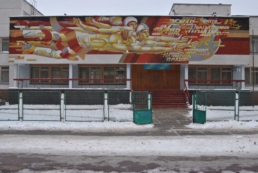
DISSIDENT MURALS
In 2013, IZOLYATSIA launched “Soviet Mosaics in Ukraine”, an online platform that studies and catalogues Soviet murals. The group had a good reason for its interest in the subject matter: it hails from Donetsk, where many of the USSR’s masterpiece mosaics can be found.
“The region was highly developed industrially by the Soviet Union, and so a lot of monumental art was commissioned there in factories and housing estates to glorify progress and labour”, says Lubava Ilyenko, IZOLYATSIA’s art historian. Working with local experts and researching independently, the group began photographing mosaics and publishing them online, complete with their addresses, links to maps and information about the artists and when they were created.
“It was important to start the project, as many mosaics were disappearing and not being researched, classified or archived”, Ilyenko says. “We decided to keep it open source [because] information in the Soviet books was not always reliable”.
According to Ilyenko, a number of the artists who produced mosaics were actually dissidents, so their names were often not even displayed next to their work: “It could be kind of a punishment really, to be made to do mosaics. Frankly speaking, it was not prestigious work. There was no opportunity to be featured in exhibitions, and artists had to work long hours outside, often in the freezing cold”.
Alla Horska was one such artist. She often clashed with the Soviet authorities and created many prominent mosaics across Ukraine. In 1963, she was one of three people who helped expose unmarked massgraves in the village of Bykivnya, where the NKVD Soviet secret police disposed of thousands of executed “enemies of the State”. She also signed protest letters against the government and was accused of being in charge of an underground organization of supporters of early 20th century Ukrainian nationalist leader Stepan Bandera.
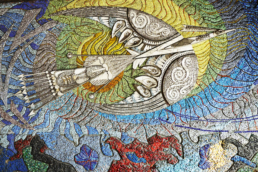
At the same time, Horska was producing mosaics across Ukraine. In one memorable case, she was commissioned to make a work for Kyiv University. In collaboration with several other artists, Horska created a stained glass mural of Ukrainian poet Taras Shevchenko. When Soviet officials came to review the work, they ordered that it be destroyed for its Ukrainian patriotism. They allegedly complained that the bars on the window and Shevchenko’s angry expression made him look as if he was in a prison. Following the incident, she was kicked out of the Ukrainian artist’s union. In 1970, Horska died under unclear circumstances. To this day, many believe she was executed by the KGB.
Because of artists like Horska, decommunization is a process tinged with irony. As it renames streets and topples monuments, it also eradicates the work of some of Ukraine’s most prominent patriots and rebels against the Soviet government.
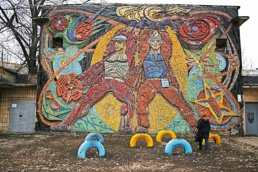
Although Soviet mosaics were typically propagandistic in theme, glorifying the worker and the peasant, the medium did offer more representational opportunities for artists. Like the Mexican muralists who often inspired them, Soviet artists were freed from the realist style and able to implement colours and symbolism derived from Ukrainian national traditions.
Boychukism — a Ukrainian art movement from the 1920’s that blended national motifs with simplified forms — continued to serve as an inspiration for mosaics made from the 1960’s onward. The movement was named for Mykhailo Boychuk, one of a number of artists executed by Stalin’s regime in the 1930’s.
PRESERVING HISTORY
For the members of IZOLYATSIA, these mosaics are an intrinsic part of Ukraine’s history. The organization has issued open calls to document and gather information on as many murals as possible. “We have people from villages in the middle of nowhere sending us photos”, explained Ilyenko. Meanwhile, local authorities across the country are covering mosaics up with metal sheets, ripping out their communist symbols or destroying them completely.
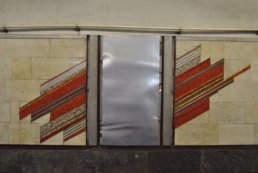
Some may perceive calls for protecting these mosaics to be attempts to glorify the Soviet period. However, Ilyenko is quick to shoot down these accusations. “Yes, in the international sphere there is a growing interest in Soviet architecture and mosaics. They resemble an interesting world phenomenon — how this medium was secularized and adopted by the communist state”, she says.
“But the ideological meaning of the mosaics should not overshadow their artistic value. That’s why this field of art must be properly researched and acclaimed. Here in Ukraine, much of the time people don’t perceive it as art because we grew up with it”.
Ilyenko argues that this is changing among the younger generation. “The preservation of mosaics is gaining popularity not because they’re interested in Soviet monuments per se, but because they struggle against the destruction of things in their city”, she says. “They want to take part in decision making. They want a more democratic and ‘European’ approach where they have a say in these things”.
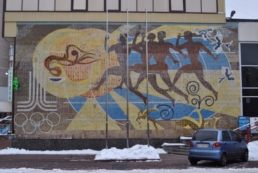
Such activists have joined forces with IZOLYATSIA on many occasions to prevent councils and private landlords from covering mosaics with advertising, or eradicating them all together.
Ilyenko believes the mosaics should be recognised for their artistic, historic and cultural value. She insists that the government should install plaques near these works explaining the Soviet symbolism and how it played a role in propaganda. “I think it could be the best, [most] civilized decision — to rethink and analyse the Soviet past, instead of refusing or neglecting it”, she says, maintaining that it would “stimulate the transformation of disputed Soviet artifacts into a touristic resource”.
Works of art caught up in a historical moment of social change and unrest can also gain discord or “conflict” value, Ilyenko says. She recalls a time when vandals in Kyiv defaced a decorative medallion of Lenin to the point that the Bolshevik leader’s face was no longer recognizable. “We managed to save what remained of it. It is important to document and record this as it opens up dialogue in society and provokes a reaction. At the end of the day, this is kind of the agency of art”.
THE ‘OTHER’ PRESERVATIONISTS
Elsewhere in Ukraine, another group has committed to preserving Soviet mosaics — albeit not for the same reasons. In the self-proclaimed Donetsk People’s Republic (DPR), decommunization has, obviously, not been implemented and the preservation of Soviet art is diligently encouraged. But this is done for political — not historical or cultural — purposes. When separatists first seized the city of Donetsk, they hung portraits of Stalin in the city center. Soviet nostalgia in the self-declared rebel “republics” continues to fuel propaganda, which focuses on building parallels between the communist era and the contemporary leadership of the separatist entities.
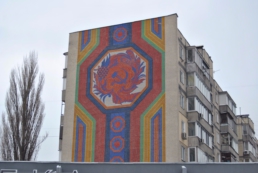
However, despite IZOLYATSIA’s longstanding work to preserve Soviet art, the activists immediately found themselves declared enemies of the separatists. In 2014, DPR militants seized the foundation’s premises and branded the work of artists promoted by the institution “degenerate”.
IZOLYATSIA has since moved to Kyiv, where the activists continue to maintain the “Soviet Mosaics in Ukraine” website. As for the future, Ilyenko says that the team hopes to launch a mobile app complete with maps and historical notes — both for mosaics and monuments removed during the first wave of decommunization in the 1990’s and the second one in 2015. She suggests there could also be an option for users to directly upload photos of mosaics they see.
Meanwhile, a planned Museum of Monumental Soviet Propaganda that was due to open in Kyiv this month has been postponed. Volodymyr Viatrovych, the controversial chairman of Ukraine’s Institute of National Memory, said that the process and organisation of the project is taking longer than expected. The museum is supposed to be housed Kyiv’s Soviet-era Exposition of Achievements complex and will contain pieces of monumental art from around Ukraine that have been dismantled under decommunization.
Although the museum could be seen as a positive step towards the preservation of Soviet art, IZOLYATSIA believe that such a solution isn’t ideal — particularly because post-World War II architecture practiced “synthesis of the arts”, which advocated the integration of art into architecture. “Most mosaics were designed to fit in with their surroundings regarding colour, composition, and size”, Ilyenko underlines. If IZOLYATSIA has its way, they will stay there.
This piece was originally published in The Odessa Review, many thanks to the editors Vladislav and Regina Marynovska- Davidzon.